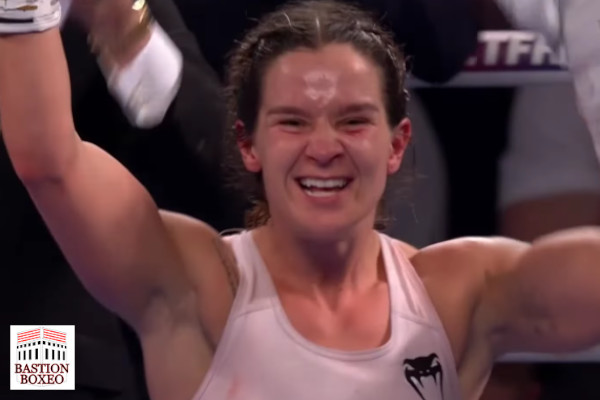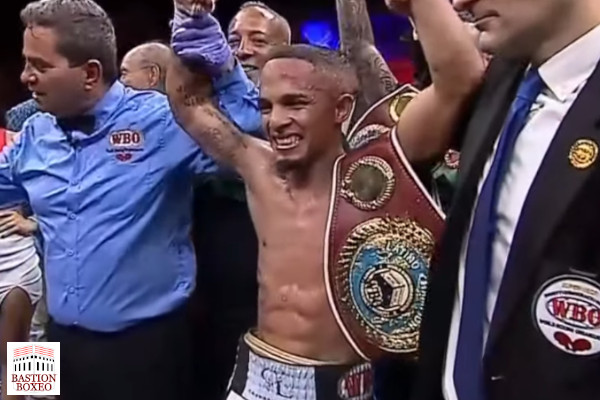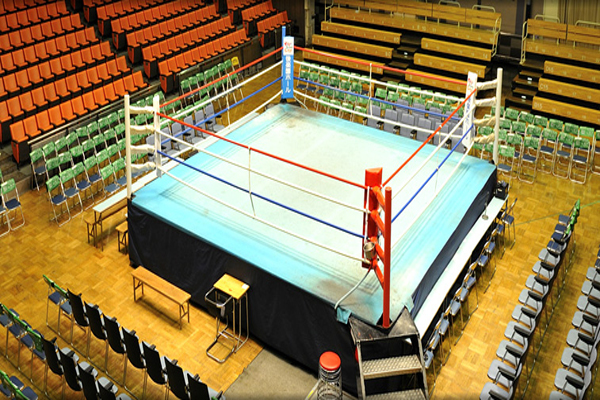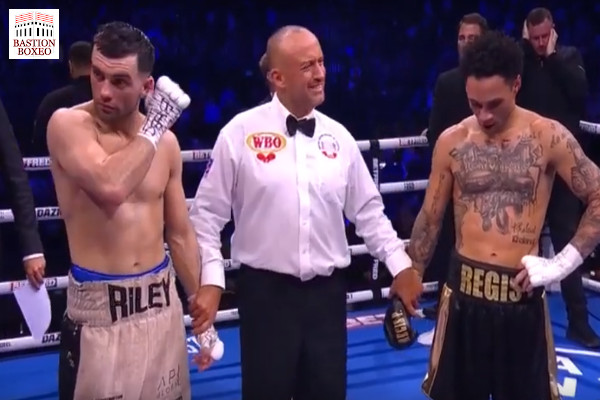Terri Harper se coronó campeona mundial superwélter, evidenciando la falta de profundidad de nivel en el boxeo femenino
Daniel Pi
@BastionBoxeo
Nottingham Arena, Nottingham, Reino Unido. Campeonato mundial femenino WBA del peso superwélter.
Imaginaos que el excampeón mundial del peso superpluma Roger Gutiérrez, después de tantear brevemente el peso ligero, ascendiese al peso superwélter de forma repentina y se proclamase campeón mundial derrotando a Jermell Charlo. Eso sólo podría significar dos cosas: o que Roger Gutiérrez es un fuera de serie o que el nivel del peso superwélter en ese momento es atrozmente bajo.
Pues bien, este ejemplo que jamás se podría producir en el boxeo masculino, se materializó en el boxeo femenino en el evento Hughes-Galahad, puesto que la exmonarca mundial del peso superpluma Terri Harper 13(6KO)-1(1)-1 ascendió desde el peso ligero al superwélter para destronar a la monarca WBA Hannah Rankin 12(3KO)-5(1). Las cartulinas de la solvente victoria unánime de Harper fueron doble 98-92 y un 97-93.
El enfrentamiento no tuvo demasiada historia, dado que simplemente la tosca Rankin no pudo acortar los espacios de forma sostenida ante Harper, que se movió constante alrededor de ella imponiendo su jab y buscando el momento para soltar uno-dos, uno-dos-hook y otras breves combinaciones. En ciertos momentos Rankin llegó con algún duro golpe de poder aislado, pero sus resultados positivos fueron demasiado puntuales, y de hecho en muchas ocasiones en los intercambios en corta fue Harper también quien conectó las mejores manos gracias a su mejor ejecución de golpeo.
Tras el combate muchos vieron este resultado como un gran momento para el boxeo femenino, como un hito muy llamativo. Sin embargo, esto sólo reflejó el pobrísimo nivel que todavía tienen muchas de las divisiones del boxeo femenino.
Es decir, si Harper que no era ni siquiera una de las tres mejores peso superpluma (Mayer, Baumgardner y Hamadouche son claramente superiores) logró el éxito de saltar cuatro divisiones en 10 meses y proclamarse campeona mundial es simplemente debido a que el peso superwélter femenino tiene un nivel medio realmente bajo, incluso aunque en los últimos años ha mejorado exponencialmente.
Esto queda aún más de manifiesto teniendo en cuenta que Harper no es la única peso superpluma que se ha coronado recientemente en el peso superwélter, ya que Natasha Jonas (con la que Harper empató) es en estos momentos campeona unificada WBC-WBO de la categoría.
Así que, aunque algunos han señalado que lo logrado por Harper y Jonas es un descomunal éxito que muestra el gran nivel que poseen ambas, lo cierto es que sólo pone de manifiesto que sus equipos han encontrado un hueco fácil para coronarlas campeonas mundiales. Y es que, quienes creen que lo conseguido por estas púgiles es algo grandioso sólo tienen que preguntarse por qué estas boxeadoras, sin tienen tantas cualidades, no buscaron una pelea titular por ejemplo en el peso superligero contra Chantelle Cameron o en el peso medio contra Claressa Shields…
En muchas ocasiones, personas optimistas y que quieren justificar que en las divisiones superiores del boxeo femenino haya un nivel muy bajo señalan que de media las mujeres suelen tener menos tamaño que los hombres, algo que es cierto.
Sin embargo, si bien es lógico que en el boxeo masculino haya muchísimos más peso wélter y superwélter que en el femenino, que tiene sus categorías intermedias en pesos más ligeros, es engañarse a uno mismo pensar que no existen muchísimas mujeres deportistas de 69,9 kg (154 lb) o con bastante más peso. Quien no lo crea sólo tiene que hacer un recorrido por cualquier deporte del mundo (como el tenis, el baloncesto, el voleibol, el balonmano, el rugby, etc.) para encontrarse mujeres en buen estado de forma de entorno a 70 kg (154 lb) o más y con una estatura muy superior al 1,73 m (5’ 8”) de Rankin y el 1,74 m (5’ 8½”) de Harper. Por otro lado, aunque no es lo más frecuente encontrarse hombres que midan 2,00 m y pesen 110 kg, esto no impide que exista en el boxeo masculino una división del peso pesado competida, interesante y con 1.300 boxeadores en activo.
En definitiva, aunque el boxeo femenino está en una situación infinitamente mejor que la que tenía hace sólo ocho años y avanza en la dirección correcta, no se le hace ningún favor fingiendo que el trabajo está hecho y que no hay nada que mejorar sólo porque en estos momentos se produzcan campeonatos mundiales de mujeres en veladas destacables.
Al contrario, al boxeo femenino le queda mucho camino que recorrer, especialmente en cuanto a aumentar su profundidad en cuanto a nivel medio (algo que sólo se conseguirá cuando haya más boxeadoras en activo con el paso del tiempo), por lo que siendo condescendientes, mirando hacia otro lado y evitando criticar no se hace lo correcto, aunque algunos piensen que sí lo hacen.

Terri Harper was crowned super welterweight world champion, showing the lack of high-level boxers in women’s boxing
Daniel Pi
@BastionBoxing
Nottingham Arena, Nottingham, United Kingdom. WBA world female super welterweight championship.
Let’s imagine that former super featherweight champion Roger Gutierrez, after briefly testing the waters at lightweight, suddenly moved up to super welterweight and became world champion by defeating Jermell Charlo. That could only mean two things: either Roger Gutierrez is an all time great, or the level of the super welterweight division is appallingly low.
Well, this example that could never happen in men’s boxing materialized in women’s boxing in the Hughes-Galahad event, since former super featherweight champion Terri Harper 13(6KO)-1(1)-1 moved up from lightweight to super welterweight to dethrone the WBA world champion Hannah Rankin 12(3KO)-5(1). The scorecards for Harper’s unanimous decision victory were double 98-92 and 97-93.
The matchup didn’t have much of a story, as the crude Rankin simply couldn’t close the distance consistently against Harper, who moved around her imposing her jab and looking for the moment to unleash one-twos, one-two-hooks and other short combinations. At certain moments Rankin landed some hard isolated power shot, but her positive results were too eventual, and in fact on many occasions in the exchanges at short range it was Harper who also landed the best hands due to her better punching technique.
After the fight, many saw this result as a great moment for women’s boxing, as a very striking milestone. However, this fight only reflected the very poor level that many of the women’s boxing divisions still have.
That is to say, if Harper, who was not even one of the three best super featherweights (Mayer, Baumgardner and Hamadouche are clearly superior), achieved the success of jumping four divisions in 10 months and proclaiming herself world champion, it is simply because the super welterweight female division has a really low average level, even though in recent years it has improved exponentially.
This is even more evident considering that Harper is not the only super featherweight that has recently been crowned at super welterweight, as Natasha Jonas (Harper and Jonas fought to a draw) is currently the unified WBC-WBO champion of this same weight class.
So, although some have pointed out that what Harper and Jonas have achieved is a huge success that shows the great level they have, the truth is that it only demonstrates that their teams have found an easy opportunity to crown them world champions. Those who believe that what these fighters have done shows their greatness only have to ask themselves why these boxers, if they have so many qualities, did not seek a title fight, for example, in the super lightweight division against Chantelle Cameron or in the middleweight division against Claressa Shields…
On many occasions, optimistic people who want to justify why there is a very low level in the higher divisions of women’s boxing say that, on average, women are usually smaller than men, something that is true.
However, while it is logical that in men’s boxing there are many more welterweights and super-welterweights than in women’s boxing, which has its intermediate divisions in lighter weights, it is deluding oneself to think that there are few women athletes of 154 lb (69.9 kg) or with much more weight. Those who do not believe it only have to take a look at any sport in the world (such as tennis, basketball, volleyball, handball, rugby, etc.) to find women in good shape around 154 lb (70 kg) or more and much taller than Rankin’s 5’8” (1.73 m) and Harper’s 5’8½” (1.74 m). On the other hand, although it is not the most common thing to find men 6′ 6″ (2.00 m) tall and with a weigh of 240 lb (110 kg), this does not prevent the existence of a competitive and interesting heavyweight division in men’s boxing with 1,300 active boxers.
All in all, although female boxing is in an infinitely better situation than it was just eight years ago and it is moving in the right direction, people are doing a disservice by pretending that the job is done and that there is nothing to improve just because currently some women’s world championships take place in remarkable evenings.
On the contrary, female boxing has a long way to go, especially in terms of improving its average quality (something that will only be achieved when, over time, there will be more female boxers), so being condescending, looking the other way and avoiding to criticize is not the right thing to do, even though some think it is.










